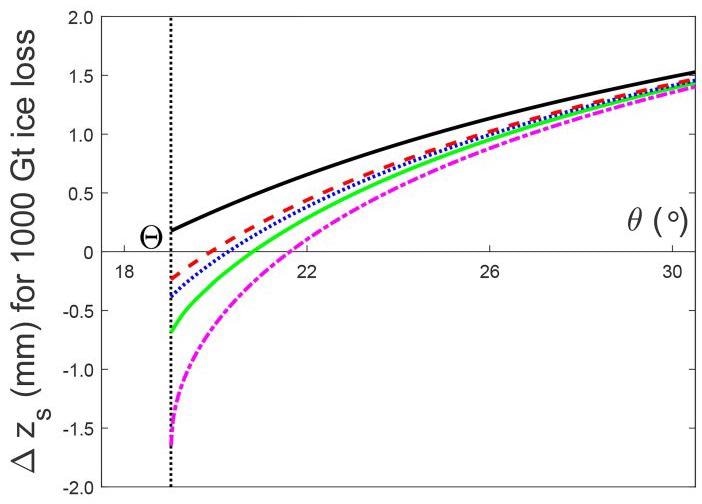Reviewed by Alex SmithApr 22 2022
People are well aware that global warming has been responsible for causing an increase in sea levels by adopting two processes. The first one is thermal expansion when water tends to expand due to its increased temperature, and the second one is the melting of land-based ice when meltwater flows into the ocean.
 The change in sea level due to melting 1,000 gigatonnes of ice from Antarctica is illustrated for different scenarios. Image Credit: Douglas A. Kurtze.
The change in sea level due to melting 1,000 gigatonnes of ice from Antarctica is illustrated for different scenarios. Image Credit: Douglas A. Kurtze.
The phenomenon of gravitational pull is less well-known in this case. When a large ice sheet melts, the global-average sea level rises, but the local sea level near the ice sheet may fall.
In the American Journal of Physics, by AIP Publishing, scientists from Saint Joseph’s University demonstrate this effect via a range of calculations, starting with an easy and analytically tractable model and advancing via gravitation of displaced seawater mass and highly advanced mathematical estimations of ice distributions.
The study includes various outcomes for sea-level change causing a 1,000-gigatonne loss of ice, along with parameter values appropriate to the Greenland and Antarctic ice sheets.
If the meltwater comes from Greenland, then sea level far from Greenland rises by more than average, but sea level at the Greenland shore actually drops. This is at least partially because of how the loss of that ice changes the gravitational pull of the ice sheet.
Douglas Kurtze, Study Author, Saint Joseph’s University
A huge ice sheet attracts seawater, causing the sea level to rise all around land on which the ice is resting. The global-average sea level increases when the ice melts into the ocean.
However, the removal of ice mass weakens the sheet’s gravity, reducing the mound. In certain cases, the decrease of the mound height might be greater compared to the increase in global mean sea level, thereby resulting in the local sea level next to the ice sheet dropping.
This phenomenon has been known to be responsible for causing dissimilarity in sea-level change from as early as the 1880s when it was found and systematically examined. Contemporary researchers made advanced and elaborate models such as other significant considerations.
This includes modifications to the earth’s rotation and changes in the shape of the solid earth, when mass, like ice and water has been rearranged on the surface.
My contribution here is to go in the opposite direction, making a model that is so drastically simplified that it can be used as an example in undergraduate courses.
Douglas Kurtze, Study Author, Saint Joseph’s University
The gravitational pull phenomenon “is a fascinating consequence of basic physics, and a great example of just how complex the earth system is—and how well geophysicists can make sense of that complexity,” added Kurtze.
Kurtze stated that he was motivated to develop his model after hearing a radio interview with Jerry Mitrovica, a Harvard professor of geophysics and renowned expert in glacial isostatic adjustment.
Journal Reference:
Kurtze, D. A (2022) Gravitational effects of ice sheets on sea level. American Journal of Physics. doi.org/10.1119/5.0067924.